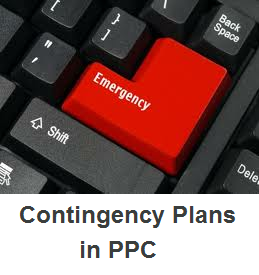As we continue through this difficult economic period of time, risk constantly increases making the chances of failing higher. We are findingourselves having to reduce the cost of many sections of the typical business. One, because reductions in costs increase profits 
As I have kind of said already, the main reason PPC campaigns are reduced in size, cost-cut or stopped is to reduce risk. Yes, of course if you don’t put as much money into PPC, you won’t loose as much if you should fail. The same applies to gambling. However, there are other ways you can reduce the risk of your PPC campaign without forcing yourself to decrease the budget of it. It’s called a contingency plan.
A contingency plan is a plan that deals with a range of possible scenarios you may find yourself in being a good situation or bad. For example, a contingency plan is a fire drill. You are preparing yourself for a situation so that you reduce the risk of (in this case) danger. Therefore, you can make a contingency plan for your PPC to reduce the risk of the failure of your campaign. This means you won’t have to change any part of your PPC campaign. A contingency plan works by reacting to the situation after it happens: not before.
When you start to make your contingency plan for your PPC campaign, you will want to all the possible scenarios your PPC campaign may go through in the future. This could be from a increased CPC of your keywords to a decrease in your click through and conversion rate. Whatever happens to your PPC campaign in the future, you will want to make sure you are prepared for it. From doing this, you can reduce the deficit of risk and help your campaign recover through a potential ‘sticky’ patch.
An example of this could be through making a contingency plan so that you can prepare yourself if your conversion rate decreases and your CTR increases. You can first find out your statistics through analysing your landing page through Google Analytics. When your conversion rate decreases and CTR increases to your contingency plan target, you can then make action. From the statistics, it can be seen that the campaign is being affect by click fraud. Therefore, your contingency plan can include ways to eliminate click fraud from your campaign.
My final piece of advice to is not to use contingency plans everywhere in your campaign. Contingency plans are more designed at larger risks than smaller ones. As well as this, you need to remember that contingency plans cost time and money to produce. This should make sure you only use contingency plans only for the larger issues.



